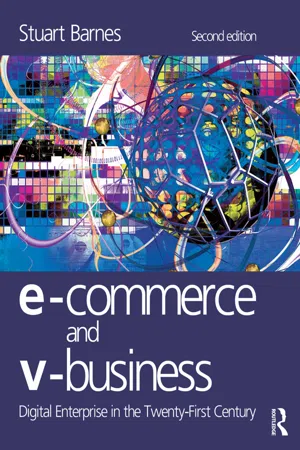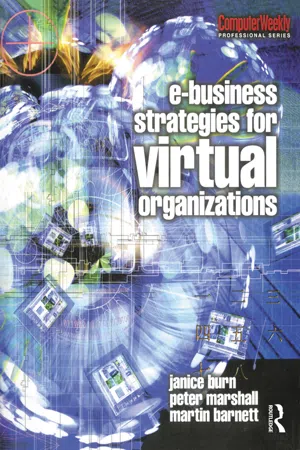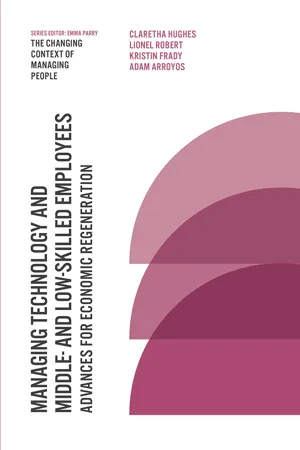Business
Virtual Organizational Structure
A virtual organizational structure is a framework in which employees work remotely, often from different locations, using technology to communicate and collaborate. This structure allows for flexibility and cost savings, as it reduces the need for physical office space and can attract talent from diverse geographic areas. Virtual teams are often managed through digital platforms and tools to ensure effective coordination and productivity.
Written by Perlego with AI-assistance
Related key terms
Related key terms
1 of 4
Related key terms
1 of 3
9 Key excerpts on "Virtual Organizational Structure"
- eBook - ePub
Organizational Behavior
Securing Competitive Advantage
- John A. Wagner III, John R Hollenbeck(Authors)
- 2020(Publication Date)
- Routledge(Publisher)
virtual memory, which refers to a way of making a computer act as though it has more memory capacity than it actually possesses. Analogously, virtual structuring provides a way to make an organization act as though it has more productive capacity than it actually controls. A structure of this type develops when a company forms a network of alliances with other companies to quickly exploit a business opportunity. Thus, a virtual structure is not a single organization but rather a temporary collection of several organizations.Levi Strauss, Atlas Industrial Door, and Dell Computer are some of the better-known companies currently implementing aspects of the virtual structuring approach.22 In virtual structures, each firm focuses on doing the thing it does best – its core competency in design, manufacturing, marketing, or any other necessary function – and together the firms form a “best of everything” organization. During the period of its temporary existence, a virtual structure resembles a loosely coupled functional structure where each “department” is an otherwise autonomous company. Connecting the various companies together is an intranet of computerized information-processing systems that takes the place of hierarchy in coordinating interdependence relationships among companies. Such coordination is accomplished mainly by mutual adjustment through e-mail, teleconferencing, and similar electronic linkages.The temporary nature of the virtual structure is the source of its flexibility, because companies can be added or eliminated as the situation warrants. In the face of this flexibility, the virtual structure’s efficiency comes from each company’s singular focus on doing what it does best. Thus it would seem that the virtual structure overcomes the efficiency-versus-flexibility trade-offs evident among the other structures just discussed. It does have some drawbacks, however. Considerable efficiency might be sacrificed by virtual structuring, owing to the cost of coordinating efforts spread among several otherwise independent firms. These costs inhibit the use of virtual structures in all but the most turbulent situations.23 - eBook - ePub
- Stuart Barnes(Author)
- 2007(Publication Date)
- Routledge(Publisher)
From this perspective, virtual organizing can be conceptualized as an essential part of the ongoing process of organizational transformation (Scott Morton, 1991). Hence, the virtual organization is postulated as a mutable – almost protean – organization in which resource allocation remains flexible to meet the changing business environment and customer needs (Ashkenas, 1995; Coates, 1993). In such a perspective the virtual organization must challenge formerly welldelineated structures so as to regenerate itself continually. As Davidow and Malone (1992) suggest:To the outside observer, the virtual corporation will appear almost edgeless, with permeable and continuously changing interfaces between company, supplier, and customers. From inside the firm the view will be no less amorphous, with traditional offices, departments, and operating divisions constantly reforming according to need. Job responsibilities will regularly shift, as will lines of authority – even the very definition of employee will change, as some customers and suppliers begin to spend more time in the company than will some of the firm’s own workers.It is our view that in the long run it might be better to speak about virtual organizing rather than virtual organizations. It seems clear that most contemporary organizations will increasingly be more or less hybrids of physical and electronically mediated organizing processes. In other words virtuality will be a matter of degree rather than an absolute state.ELEMENTS OF THE VIRTUAL ORGANIZATION
From the above, it seems evident that the virtual organization is almost the perfect antithesis of the traditional bureaucratic organization whose efficiency is built on principles such as: a clear division of labour that indicates clearly demarcated jurisdictional areas, well-defined hierarchical structures, impersonality in dealing with a variety of cases, general rules for the execution of work processes, professional expertise, and so on (Weber, 1947; 1948). However, what does this mean? How will this entity (if we can call it this) operate? To answer these questions we need to introduce some other notions central to the idea of virtual organizing. - eBook - ePub
- Janice Burn, Peter Marshall, Martin Barnett(Authors)
- 2007(Publication Date)
- Routledge(Publisher)
et al. 1998). In the face of change and uncertainty in business, virtual organizations offer a low cost, highly responsive and adaptable way to organize and compete. This chapter deals with the essential reasons why virtual organizations are an effective way to organize. In presenting this argument we will examine the essential features of virtual organizations, then go on to examine some essential business processes that characterize the operation of virtual organizations, and then finally deal with the issues involved in successfully managing virtual organizations.2.2 Characterizing the essence of the virtual organization
When reading the literature on the virtual organization, we find the online concept and the collaborating parties concept, and the hybrid that combines these two concepts.2.2.1 The online VO
For some, a virtual organization is essentially an electronic one, an online organization. Proponents of this position offer Amazon.com and Ebay.com as examples of organizations that have been created primarily to exist in and exploit the opportunities offered by the WWW and cyberspace. This so-called virtual, or electronic, organization is discussed in contradistinction to the traditional ‘bricks and mortar’ retail outlet.2.2.2 The collaborative VO
An alternative to this first definition is to present the virtual organization as an organizational structure based primarily on the notion of collaborating entities, coming together to share competencies, skills, knowledge and other resources for the purpose of producing a particular service or good, or of taking advantage of a particular opportunity. While there is the clear expectation that IT and telecommunications would play an important role in coordinating and controlling the activities of disparate components of the virtual organization, IT becomes a key component, rather than the distinguishing characteristic. - eBook - ePub
Projects Without Boundaries
Successfully Leading Teams and Managing Projects in a Virtual World
- Russ J. Martinelli, James M. Waddell, Tim J. Rahschulte(Authors)
- 2017(Publication Date)
- Wiley(Publisher)
They have implemented approaches that minimize organizational hierarchies while de-emphasizing departmental silos and adopting more flexible organizations with horizontal networks of personnel and resources. This transition was spearheaded by many companies in the high-technology industry to take full advantage of their internationally distributed workforces. 2 This fundamental change in thinking is based on four foundational success factors for virtual organizations and their virtual project teams: 3 Virtual project managers need direct access to the senior management leadership of the enterprise. Successful execution of virtual projects is dependent on effective management of the interdependencies and interfaces among the distributed team members. Geographically distributed virtual project members need timely and complete access to all important technical and business information that directly impacts their project. Decision making power must shift from the top of the organization to the virtual project team within clearly defined decision boundaries. Figure 9.1 Example Virtual Organizational Structure Traditional, hierarchical organizational and team structures create a direct barrier to these four virtual project success factors. To ensure alignment between a firm's business strategy and its virtual project execution output, senior managers and virtual project managers must have direct access to one another. They must, in fact, work together as a leadership team. Traditional hierarchical organization structures normally prevent this from occurring due to the layers that exist between senior executives and project managers. The greater the number of layers between project managers and top-level management, the greater the probability of misalignment between strategic goals and execution output - eBook - ePub
Organizational Behavior
A Management Challenge
- Linda K. Stroh, Gregory B. Northcraft, Margaret A. Neale, (Co-author) Mar Kern, (Co-author) Chr Langlands, Jerald Greenberg(Authors)
- 2001(Publication Date)
- Routledge(Publisher)
27However, just because boundaryless organizations are less formal doesn’t mean that the work their members perform is easier than the work of people in formal structures— it’s just different. In a study of a commercial lending institution, Robert Cross, Aimin Yan, and Meryl Reis Louis found that in boundaryless organizations work was divided among all levels of the company—everyone was responsible for elements such as goal setting and strategic planning.28 This is in direct contrast to formal structures, where the majority of work, such as goal setting and strategic planning, is reserved for upper management.VIRTUAL STRUCTURES. Virtual structures were a logical outgrowth of developments in technology and global expansion in corporate America, and are an outgrowth of the boundaryless organization. A virtual structure is an evolving network of organizations or firms joined to share skills, costs, and resources.29 A challenge to traditional organizations, virtual structures are typically assembled only temporarily and for specific reasons. In addition, in their purest form they have practically no structure at all—no organizational chart, no central office, and no hierarchy.FIGURE 14–5 Characteristics of Bureaucratic and Organic OrganizationsRESEARCH IN ACTIONFROM DOWNSIZING TO RESPONSIBLE RESTRUCTURING
Wayne F.Cascio, University of Colorado-Denver; .When confronted with the need to reduce costs, many of the same executives who tout people as “our greatest assets” see those assets as ripe opportunities for cutting costs. My research, funded by the U.S. Department of Labor, punctured a number of myths about downsizing as a strategy to improve corporate profitability, and it identified an alternative approach, termed “responsible restructuring.” Instead of asking “What’s the irreducible core number of people we need to run our business?” responsible restructuring asks “How can we change the way we do business, so that we can use the people we currently have most effectively?” - eBook - ePub
- Paul Boreham, Rachel Parker, Paul Thompson, Richard Hall(Authors)
- 2007(Publication Date)
- Routledge(Publisher)
This chapter has been devoted to an assessment of the relationship of organizational change to major transformations in the social, economic and technological context in which work takes place. The views that we have canvassed have become quite pervasive in the social science literature. They portray a scenario in which organizations are required to ‘re-engineer’ themselves to react flexibly to a globalized market place which is neither predictable nor subject to many of the conventions upon which production has been based in the past. It is argued that responding to these conditions will require a retreat from many of the aspects of traditional bureaucratic forms of organization, and an embrace of new forms for organizing work activities. Such forms of organization call for the abandonment of hierarchical structures in many areas of the workplace, an increase in the autonomy of workers and work teams, and a much greater reliance on temporary and often distributed networks of expertise and of production itself (Hughes, O’Brien, Randall, Rouncefield and Tolmie 2001). Information and communication technologies provide the technical structure and telework provides the employment framework which underpin these ‘virtual organizations’ (Castells 1996; Cooper and Rousseau 1999; Hinds and Kiesler 2002; Jackson 1999; Igbaria and Tan 1998; Woolgar 2002a).Trust and control in the virtual workplace
It is not necessary to accept the entire package of claims about information and communications technologies and the new virtual workplace to recognize that management has been placed under considerable pressure to improve labour productivity and quality. A substantial restructuring of the labour process focussed on innovation and continuous improvement has led many companies to modify aspects of the traditional Fordist production regime (Callaghan and Thompson 2001; Osterman 1994). This has manifested itself in practices such as quality circles, employee involvement and teamworking which require a work process geared towards group decision-making, problem solving and multi-skilling (Warhurst and Thompson 1998:6). Employees are required to be integrated into the management of production at the workplace level (Milkman 1998:31).However, it is essential to emphasize that the changes to work organization of which technologies are capable are largely a factor of the strategic decisions of those who deploy them. In other words, technologies can be advantageous in furthering significantly different approaches to workplace organization. What is most unlikely is that management will adopt a new system of workplace relations simply on the basis of an improved technical capacity to do so. By far the greatest determinants of change or resistance to change are existing ideas and assumptions about the management of the workplace and the organization of work. This is particularly the case for the new ‘high performance’ workplace with its emphasis on new participative relationships (Whitfield and Poole 1997; Wood 1999b). - eBook - ePub
- Baden Eunson(Author)
- 2012(Publication Date)
- Wiley(Publisher)
Chapter 5 Networks, virtual organisations and networkingDifferent organisational designs can have different effects on workplace communication. However, remember that these are not mutually exclusive categories — one organisation may have different mixes of span of control and centralisation and mechanistic/organic characteristics at differing phases of its development.Now I’m going to look at what happens when an organisation becomes thoroughly decentralised, so that it resembles a dispersed network rather than a monolithic hierarchy. I will also analyse another network pattern — the network roles played by individuals predominantly at the intra-organisational levels. I will then look at the concept of networking — a set of interpersonal strategies that can benefit the organisation and the individual who deploys them.All these variations on the theme of networks touch on the interconnectedness of people, sometimes in the most surprising way. According to the small world phenomenon, for example, any person on the planet may be separated from any other person by no more than ‘six degrees of separation’. There may also be other patterns or networks of interconnection that people are only now becoming aware of.Networks, telecommuting and boundaryless virtual organisationsAn organisation can be described as a network. The demands of technology and globalisation, and the lifestyle preferences of employees, are driving changes in the structure or design of many organisations, some of whose employees are increasingly working at a geographic distance from one another. Employing different mixes of communication channels, increasing numbers of people now work in ‘virtual teams’ within a boundaryless or networked virtual organisation. Such telecommuters work out of their homes, connected to a central workplace via computer, phone and video links. - eBook - ePub
The Self-Made Program Leader
Taking Charge in Matrix Organizations
- Steve Tkalcevich(Author)
- 2015(Publication Date)
- Auerbach Publications(Publisher)
3 Understanding Your Organizational StructureLooking back at Chapter 1 and the mind map of influential leaders you created, how do you currently stand with your identified skills for improvement, leadership traits, and your overall progress? This mind map will start each chapter to guide insight from this book and will give you the opportunity to compare your goals and progress along your journey. Always have an open discussion with your group of six to ten professionals on where you stand and if you have any roadblocks (Figure 3.1 ).If someone asks you what an organization is, what would you tell them? What does it mean to you? It can be best defined as a collective group of people systematically arranged to meet a need or obtain an ongoing goal. An organization structure is a framework that shows others the lines of authority, dictates formal communication channels, and allocates duties and rights to individuals. How does the organization structure impact the goal of the company? How does the structure affect the role of a project, program, or portfolio manager? Are there ways a project, program, or portfolio manager can maneuver and succeed in any organization structure? These questions have merit and will be discussed in this chapter.What makes one choose a particular organizational structure over another? There are times when multiple structures may have merit, but only one can be selected. Understanding the makeup of your organization structure will only work in your favor. There are four major factors that affect an organization’s structure: technology, strategy, human resources, and the organizational environment. These factors determine the organizational structure that will be used for the organization. Aligning the strategy with the direction your firm is headed will allow for smoother operations for example. This direction comes from top management with the involvement of the entire management team. Managers often work tirelessly to maintain the course set forth by the strategic direction and goals of the organization. - eBook - ePub
Managing Technology and Middle- and Low-skilled Employees
Advances for Economic Regeneration
- Claretha Hughes, Lionel Robert, Kristin Frady, Adam Arroyos(Authors)
- 2019(Publication Date)
- Emerald Publishing Limited(Publisher)
Coordination involves the managing of roles and their interdependencies to ensure that work is integrated across role activities. Interdependencies represent the degree to which roles are dependent on one other to accomplish work. The most common coordination mechanisms include roles, plans, and technology (Okhuysen & Bechky, 2009). The expectations associated with a role can include the managing of work interdependencies. For example, the role of a manager often involves managing work interdependencies across roles. Plans can also be used to coordinate work by creating a common understanding of what needs to be done across roles. Technology can be used to digitalize and help visualize plans or to support roles.Challenges to Organizing in Virtual Teams
Aligning the Organizing with Planning
Planning can directly inform both structuring and coordinating but not always. Ideally, we can imagine a situation where the virtual team is organized around the plan. In this case, the team is built from the ground up. In many cases, the virtual team already exists and the team attempts to adjust to the plan, or the plan is revised to account for the team. In either case there is the possibility that the planning and organizing are not well aligned. This can lead to failed goals, objectives, and dysfunctional team behavior.Structuring and Coordinating Virtual Teams
Geographic and temporal dispersion can make it difficult to structure and coordinate roles. Both can undermine the ability of a virtual team to support structure. This is particularly problematic for centralized hierarchical structure. The time needed to make decisions increases when teams rely on a single or a few individuals to make all team decisions. This approach can be even more problematic when teams are geographically and temporally dispersed and rely primarily on asynchronous electronic communications. The delays often lead to frustration and poor team performance (Cummings et al., 2009).The biggest problem regarding coordination in virtual teams involves the identification of role interdependencies. Planning involves the initial assigning of roles and responsibilities. However, this is not enough for several reasons. Role interdependencies are often not readily apparent and only surface later once the work actually begins. Work responsibilities evolve throughout the team’s tenure. Both geographic and temporal dispersion make it difficult to identify role interdependencies by reducing communications and a shared understanding.
Index pages curate the most relevant extracts from our library of academic textbooks. They’ve been created using an in-house natural language model (NLM), each adding context and meaning to key research topics.
Explore more topic indexes
Explore more topic indexes
1 of 6
Explore more topic indexes
1 of 4








